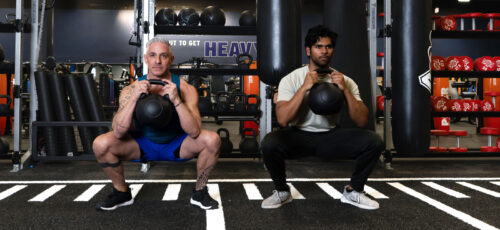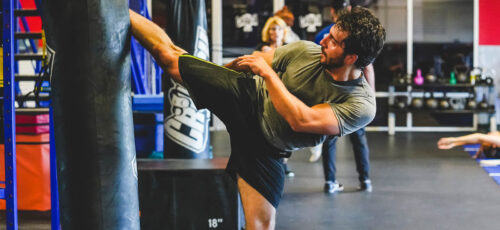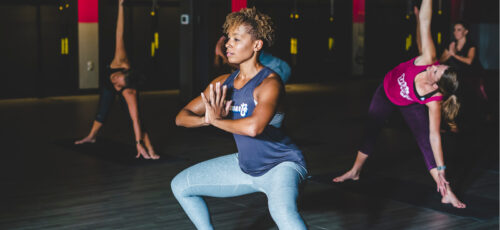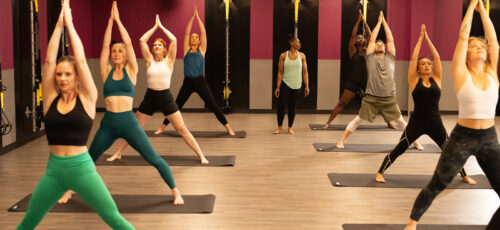
Stressing yourself over the routine you must follow and endlessly asking Google: “How many yoga classes should I do each week to see results”, kind of defeats the calming effect and purpose of yoga.
At the beginning of anyone’s yoga journey, understanding how much yoga you should practice can be tricky, especially if you don’t have the assistance of a professional yoga teacher. Finding a way to feel balanced and calm can be hard. That’s where yoga comes in.
Yoga isn’t just exercise; it’s a mix of exercise, thinking, and feeling good. It’s more than just moving your body, it’s about feeling good inside and out. Practicing yoga can make your body more flexible, stronger, and help you lower your stress levels.
Today, we’ll learn how many yoga classes you should incorporate into your daily routine and how in a few months, your physical and mental health will thank you.
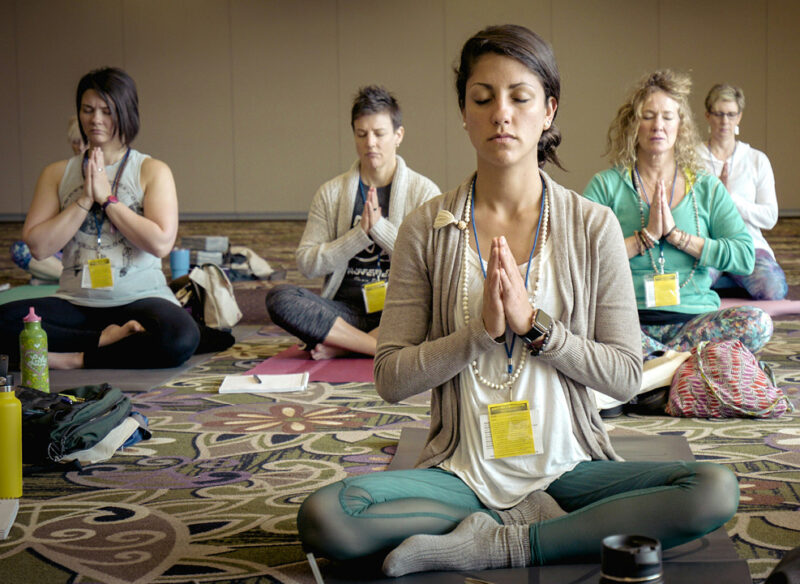
Setting Your Goals
Start by considering what you want from yoga. Do you aim to be more fit, improve your mental well-being, or connect with your spiritual side? Choosing the right classes based on your goals is the first step. Everyone is unique, with different preferences, some seek strength, some seek relaxation, and others crave a deeper connection with their inner selves. Adapting how you practice yoga to align with your needs is crucial for a fulfilling experience.
Now, think about your daily routine. When is the best time for you to practice yoga? Knowing your free time makes incorporating yoga into your daily routine easier. If you just want to squeeze in a quick one at home, you can try one of our Crunch+ workouts to level up your Yogi skills!
Yoga classes come in easy, medium, or hard levels. Beginners benefit from easy classes that teach the basics, while those advancing might prefer medium or hard classes for a challenge.
Paying attention to your body is essential. Listen to how it feels and avoid being injured practicing yoga. Whether you’re seeking stress relief, improving the mind-body connection, working towards weight loss, or enhancing overall health, adapting your practice to your needs fosters a more holistic and fulfilling yoga journey.
Exploring Yoga Class Options
Stepping into a well-being path through yoga is to listen to your body, it’s exploring diverse class options, each contributing to health benefits. From foundational classes for beginners to advanced sessions, the world of yoga offers tailored experiences for every stage.
From practicing asanas to focusing on mental health, weekly yoga sessions become a tool for overall well-being. Stress relief, improved balance, and weight loss goals are addressed through the right class choice and consistent daily practice. Let’s see which one is best for you!
For Beginners: Starting Simple
If you’re new to practicing yoga, beginning with basic classes, such as Hatha Yoga, Yin Yoga or The Slow Down – Restore by Crunch+, is a smart move. These classes not only teach you simple poses but also help you get comfortable with yoga, fostering a good balance between physical and mental well-being. Listening to your body is encouraged during these foundational sessions.
For Middle-Level Yogis: Going Deeper
For those practicing yoga regularly and seeking a deeper experience, trying various classes like Iyengar Yoga, Power Yoga, Hot Yoga or BURST! Stretch – Mobile Yogi is a beneficial choice. Mixing things up not only enhances your knowledge but also keeps your yoga sessions interesting, supporting overall health, and contributing to yoga goals.
For Advanced Practitioners: Getting Better
Experienced yogis benefit from fine-tuning their routines, like in Ashtanga yoga. Focusing on advanced poses, incorporating breathwork, and getting into meditation elevates their practice to new heights. This advanced exploration, including practicing asanas and embracing various yoga styles, goes beyond physical benefits, extending into the realms of mental health and well-being. It provides a comprehensive approach to achieving yoga goals, whether that’s improving flexibility, mental clarity, or even weight loss. Buff Yoga by Crunch+ is also a Hit for the Advanced Yogi!
Thinking about how hard a class is matters. Doing challenging classes too often can be critical. It’s good to balance hard classes with easier ones and rest days. Taking breaks is important. LISTEN TO YOUR BODY! It needs time to rest and recover.

Listening to Your Body: Signs of Overtraining
Attuning to your body is essential for a steady yoga practice. Recognizing signals of fatigue allows for necessary adjustments to avoid overtraining.
Burnout is a real concern in any fitness routine. Taking sufficient rest and recovery days becomes crucial for preventing burnout, giving your body the necessary time to heal and rejuvenate.
Since energy levels vary, adjusting your practice frequency is key. Some weeks may warrant more intense sessions, while others may demand a gentler approach. Tuning into your body’s signals ensures a sustainable and enjoyable yoga journey.
Rest days are considered a good balance, recognizing that a calmer mind and improved balance are integral to reaping the most benefits from your practice. For the average person, a general rule is to incorporate rest days for maximum benefit, aligning with the fluctuations in energy levels experienced in daily life. Making yoga a part of your routine not only aids in improved physical health but also contributes to enhanced mental well-being.
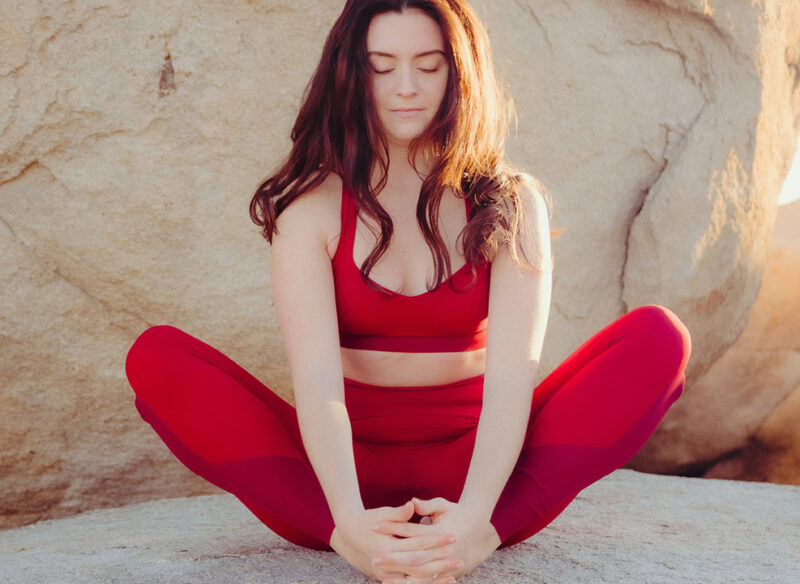
Creating a Balanced Yoga Routine
Yoga transcends mere physical postures; it’s a comprehensive journey toward overall well-being. To enhance your regular yoga practice, consider incorporating meditation, breathing exercises, and reflective moments. This multifaceted approach not only enriches your daily yoga practice but also contributes to mental health, providing a more balanced and fulfilling experience.
Ensuring that your daily practice aligns with your energy levels and individual needs. Whether attending yoga sessions at a studio, practicing at home, or participating in workshops, the frequency of your practice per week should be tailored to your goals and lifestyle.
Explore various yoga styles such as Hatha Yoga, Iyengar Yoga, Power Yoga, Hot Yoga, or Yin Yoga, depending on your preferences and yoga goals. Practicing asanas becomes more meaningful when integrated into a routine that embraces the diversity of yoga practices.
Whether you aim to lose weight, enhance flexibility, or simply nurture your mental well-being, a well-crafted and varied yoga routine, supported by daily practice and an attentive approach to your body’s signals, paves the way for a fulfilling and transformative yoga journey.
Your Ideal Yoga Practice Schedule
In the end, doing yoga regularly is a personal journey. By picking the right number of classes, listening to your body, and making a balanced plan, you can make yoga a part of your life. Yoga isn’t just about exercise; it’s about making your mind, body, and feelings happy. Try to be consistent, and let yoga be your guide to feeling good every day.
Join Us!
Crunch promotes a culture of positivity, inclusivity, and fun with no judgments by providing an environment for all individuals regardless of their health and fitness goals. Find a Crunch gym near you to try our free trial membership, or join Crunch now. We’re here for you – at the gym or at home. Access the best live & on-demand workouts anytime, anywhere with Crunch+. Ready to get sweaty? Try hundreds of workouts for free! Start your free trial now!

















